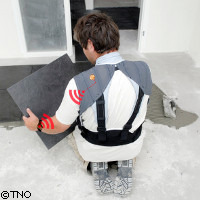EU project develops smart fabric to ease worker pain
Do your muscles ache after clicking your mouse and staring at your computer screen for hours on end? Experts tell us that we must take short breaks throughout the day, but many of us often ignore the advice, at the risk of causing repetitive strain injury (RSI). This is about to change. Thanks to a group of European researchers, a smart fabric that can monitor muscular overload and help thwart RSI has been developed. The EU-funded Specific Targeted Research Project ConText initially sought to establish a system whereby various sensors are integrated into textiles to be used in continuous monitoring of individuals. Funding for the project amounted to EUR 2.3 million. The ConText ('Contactless sensors for body monitoring incorporated in textiles') project partners told ICT Results that the contactless sensors would be used to measure electromyography and electrocardiography signals. The sensors would be incorporated into textiles so as to generate a prototype of a wearable vest. Bringing together textile and signal processing of the myographic signals will play a key role in making personalised health applications a reality. This move is a giant leap forward compared to obstacles researchers have faced in the past when trying to get innovative smart fabrics off the ground - problems related to reliability and unobtrusiveness hampered their efforts. RSI costs can reach billions of euros each year, and more than 40 million European workers suffer from this injury. Data have shown that RSI accounts for around half of all work-related ill health, and experts say repetitive actions could also result in permanent injury. The project partners remarked that long-term, low-key stress is the leading risk factor for RSI. During the 30-month project, the researchers focused on resolving three issues: to use an innovative sensor requiring sophisticated electronics to be located in the clothing, to measure muscle contraction, and to investigate how muscle contraction could be used as a predictor of stress. 'Each of the issues was very difficult. We chose to use a capacitative sensor, because it does not need to be attached to the skin, like resistive sensors do, which adds to the comfort,' ConText project leader Bas Feddes was quoted as saying. 'It needs controlling electronics close to the sensor to work effectively, and that presents a real challenge for textile integration.' As the researchers pointed out, measuring electromyography or electrical activity in the muscle is more challenging than using electrocardiography, which measures the heart. Why? Because movement triggers the rustling of clothing, which can drown out the signal, ICT Results reported. While the problems proved challenging, the ConText team succeeded in moving forward with the design of an RSI vest. The partners are now working on enhancing its reliability. The ConText team also said that their smart fabrics could be used for pregnancy monitoring belts and sports clothing, such as a wearable physical game controllers, and athletic wear that could give training tips. The upshot of this research project is that it will fuel other projects in the future. 'It is an interesting area with many potential applications,' said Mr Feddes. 'We would like to pursue other areas together in a future project.'



